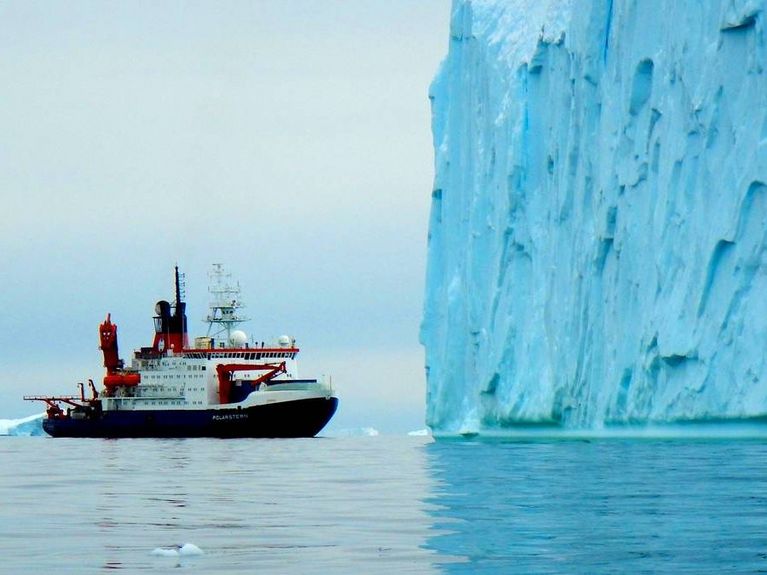Surprising findings
How the Antarctic Ice Sheet was formed

The FS Polarstern in front of a mighty iceberg in Pine Island Bay. Picture: Alfred-Wegener-Institut / Johann Klages
A unique core from the ocean and complex climate calculations have revealed when and where the Antarctic ice sheet formed. According to the study, the continent slowly froze from east to west 34 million years ago. The results, published in the journal "Science", help to further improve climate calculations.
People often talk about "eternal ice" when it comes to Antarctica, but there is no such thing, as about 34 million years ago the southern continent was completely ice-free. Vast forests of shaggy southern beech covered much of the continent, akin to those that can still be found today in Patagonia at the southern tip of South America. Wide rivers and small streams meandered through the fertile land, which would be completely covered by ice just a few million years later. Until now, it has been unclear exactly how and where Antarctica froze. When did the first long snowfalls begin, and where did the first thin ice cap form?
A German-English research team led by the Alfred Wegener Institute, Helmholtz Centre for Polar and Marine Research (AWI) has now found the answers by analyzing sediments from the bottom of the Antarctic Ocean that are many millions of years old, and by using accompanying computer model calculations. According to the results, Antarctica began to slowly freeze 34 million years ago, starting in the coastal region of East Antarctica. Until now, experts had assumed that the glaciation began in the center, because it is particularly cold there. "This is not the case," says project leader and AWI geologist Johann P. Klages. "In order for snow and ice to form, there had to be moisture in the air, which was transported by warm ocean currents from the direction of present-day Tasmania". It has been known for some time that the concentration of the greenhouse gas carbon dioxide was slowly decreasing at that time, in contrast to today, when the Earth was getting colder and colder. "In this respect, the results of our study are particularly interesting for the future," says Klages. "If we know how and where Antarctica slowly froze back then, we can better estimate how it might melt in the future as a result of global warming."
Picture: IODP / Thomas Ronge
For many years, scientists have assumed that large ice masses must have formed somewhere on Earth 34 million years ago. This is indicated by chemical traces from the past. But until now, no one knew where this glaciation took place. Thanks to a combination of sediment samples and climate calculations, Klages' team has now been able to solve the mystery. During a Polarstern cruise, they drilled sediment from the seafloor directly off the west coast of Antarctica for the first time. They used the MeBo70 drilling rig from the Marine Research Institute MARUM in Bremen, which is capable of penetrating even hard sediments such as those found in West Antarctica. The analysis of the cores was a minor sensation. The material contained enormous quantities of pollen, spores and plant remains. "And they were from exactly 34 million years ago," says Johann P. Klages. "This made it clear that West Antarctica was still densely forested at that time. The ice must have formed somewhere else.
To find the core of the Antarctic ice sheet, he asked his colleague Gerrit Lohmann, head of paleoclimate modelling at the AWI, to run the ice formation through the computer. "With the knowledge of West Antarctica, which was still green at that time, we went to work and analyzed the situation," says Gerrit Lohmann. "For the first time, we combined several complex climate models, one for each the atmosphere, the sea, the vegetation and the growth of the ice sheet." The results were a perfect match: 34 million years ago, East Antarctica began to freeze from the edge. West Antarctica followed seven million years later. No wonder so much plant material from 34 million years ago was found in the sediments of West Antarctica.
Grafic: MARUM / Martin Künsting
As described above, Antarctica slowly froze over at that time because the carbon dioxide level in the atmosphere was dropping. An important reason for this was the formation of several large mountain ranges; the Alps, the Himalayas, and the Caucasus. As the mountains grew, rain washed more minerals out of the rocks. These reacted with carbon dioxide from the atmosphere to form carbonate, which was deposited at the bottom of the oceans for a long time. As a result, the concentration of CO2 in the air continued to fall. "Our model calculations show that East Antarctica slowly iced over from a concentration of around 840 ppm, and West Antarctica glaciated only later at below 560 ppm," says Gerrit Lohmann, "which is only about 150 ppm more than today. Conversely, this means that in the future, if carbon dioxide concentrations reach these levels again due to climate change, the melting in Antarctica is likely to start in the west first. "In fact, we are currently heading towards such levels," says Lohmann. The new knowledge about Antarctic icing will help climate modelers around the world to calibrate their models more accurately in the future, and to better assess the future of the Arctic ice sheet.
Readers comments